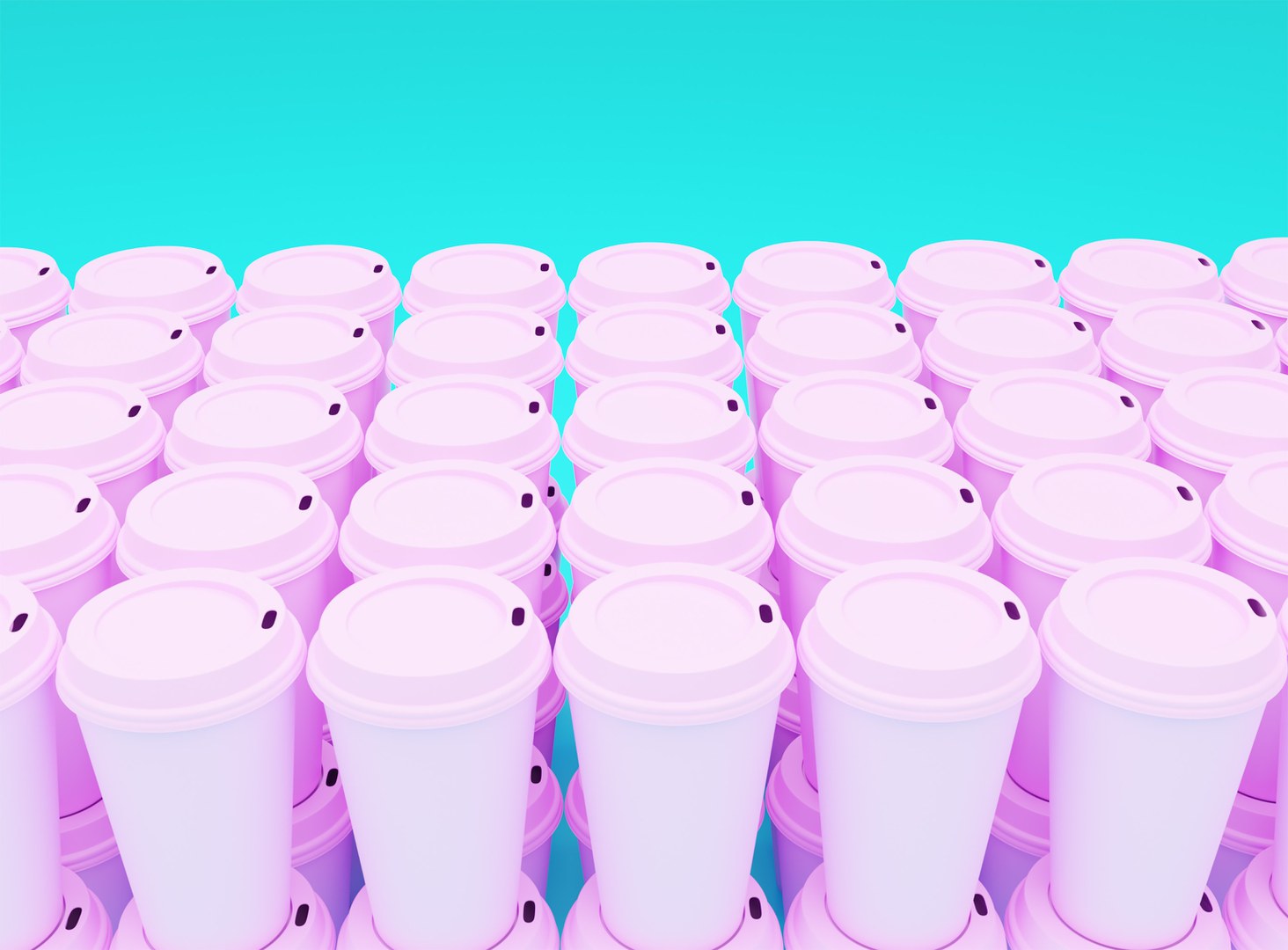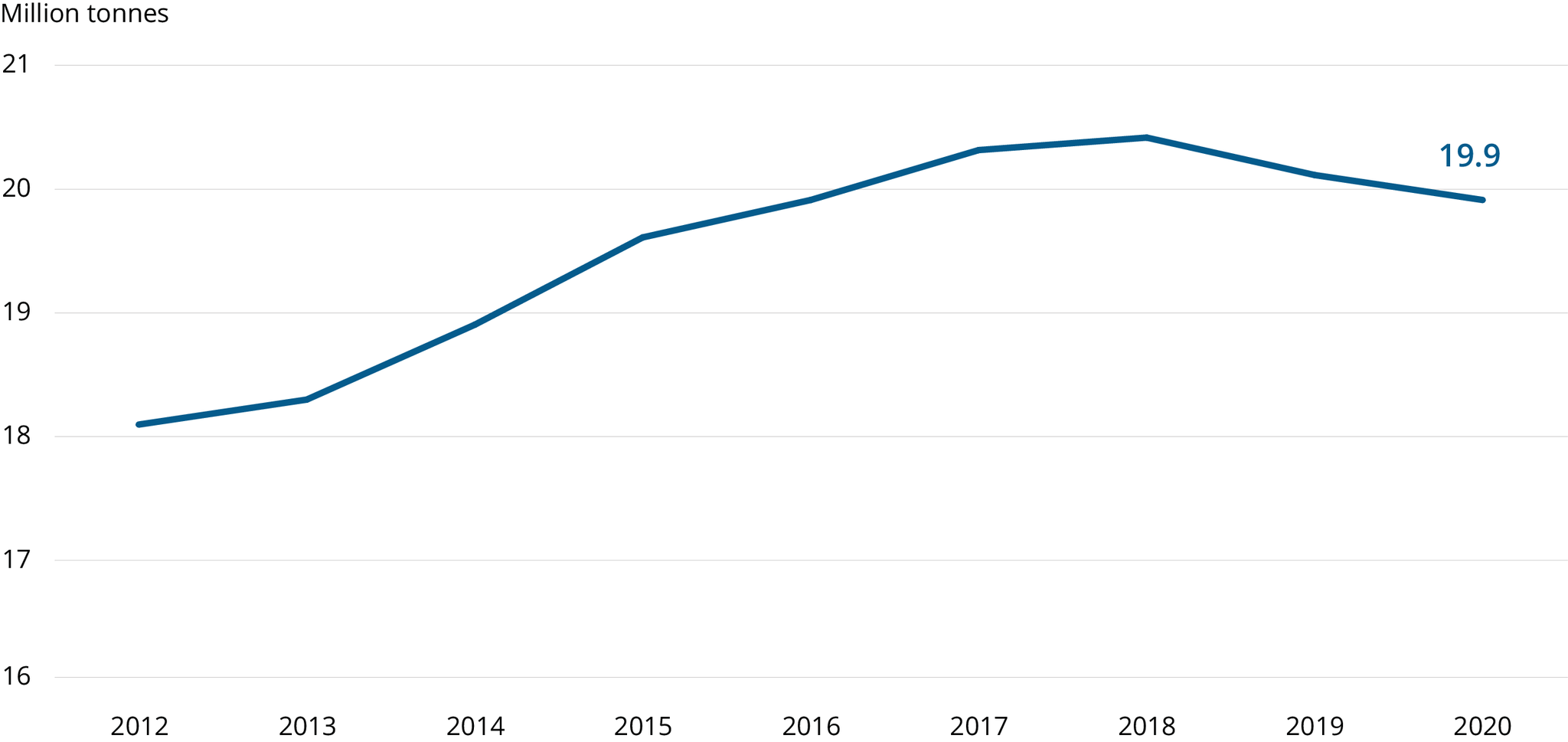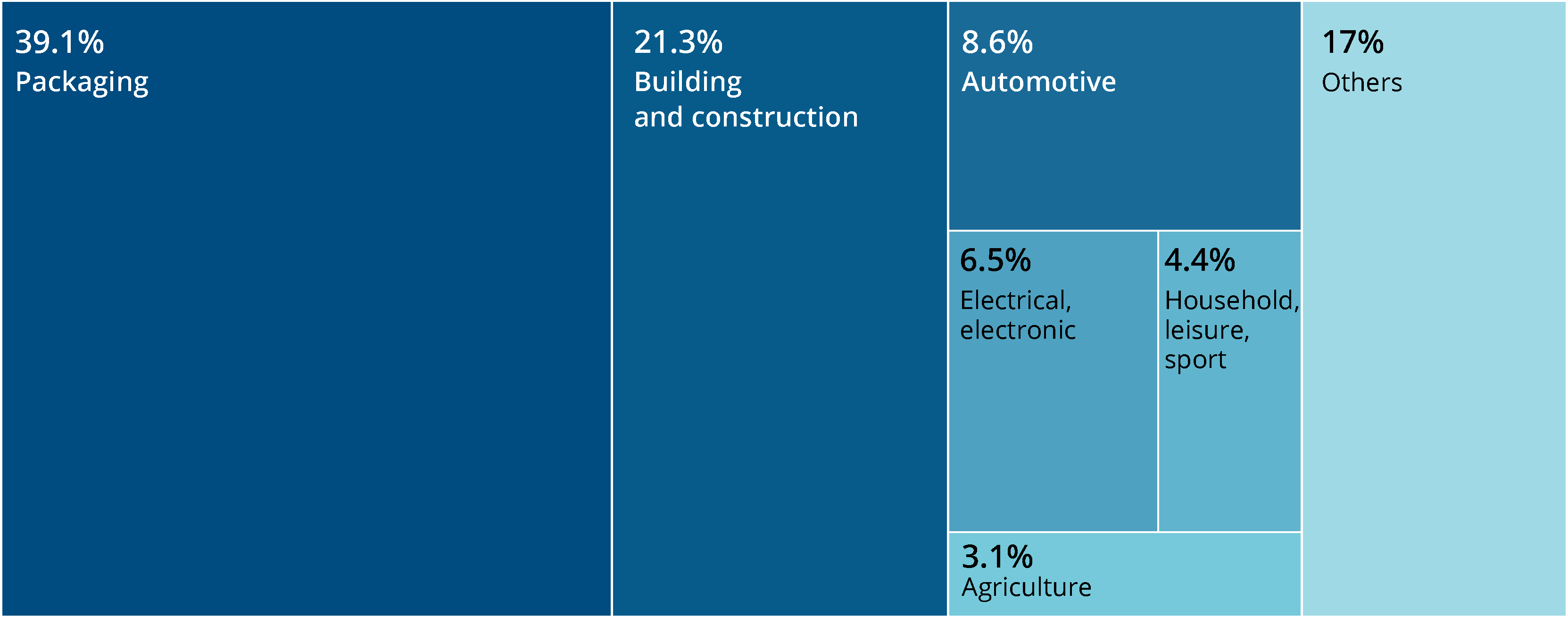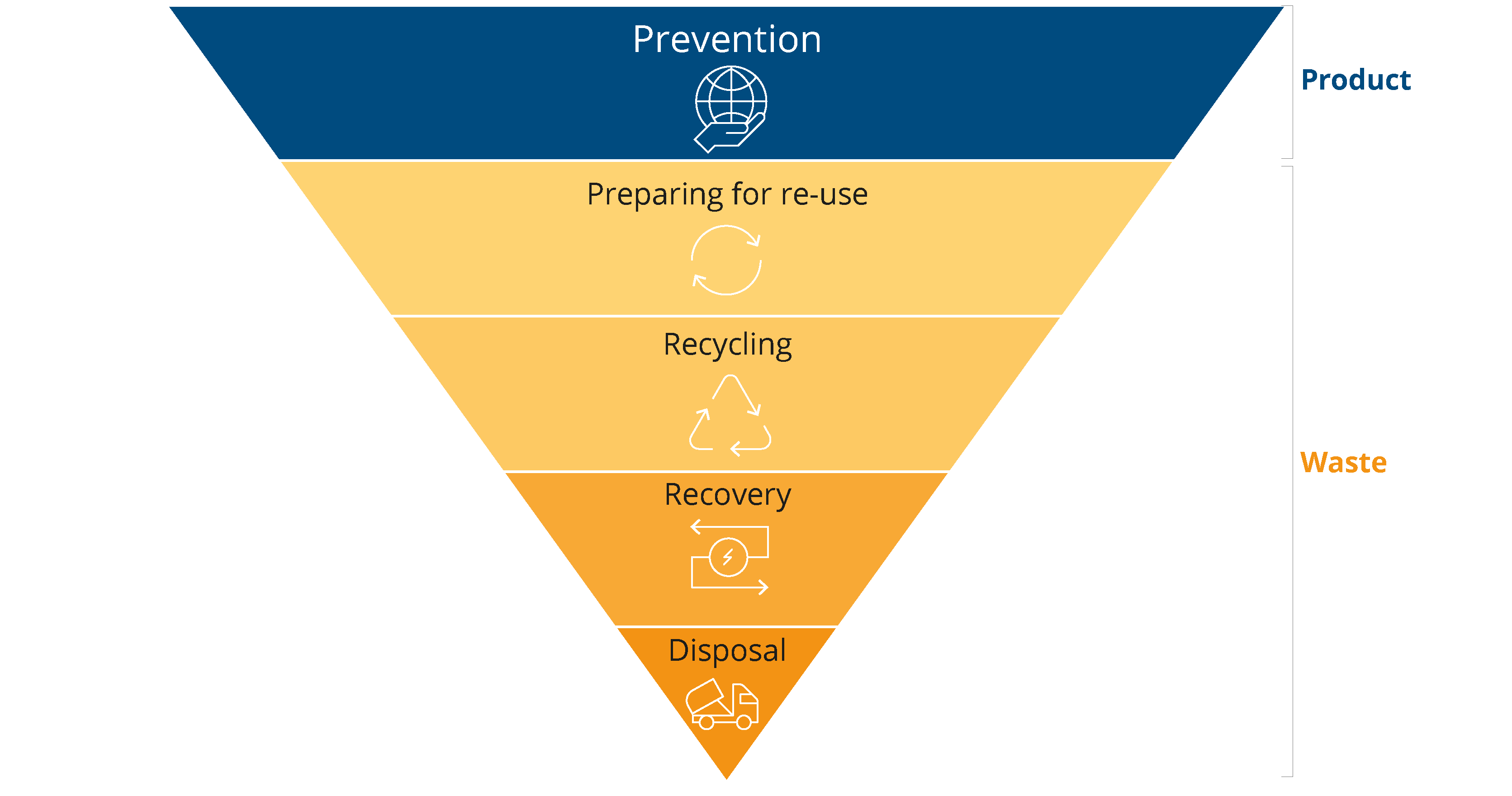What do we know about marine litter?
‘Marine litter’ is defined as ‘persistent, synthetic or processed solid items or fragments discarded or abandoned’. It can reach coastal and marine environments directly, but most often, it is carried by rivers into the sea.

Source: PPSI (ETC/ICM, 2022) , (EC, 2021)
Plastic pollution arising from land is by far the biggest and most worrying part of the problem. It accounts for approximately 85% of marine litter (UNEP, 2021). Products and processes to satisfy human needs, health and well-being — such as the production, delivery and safety of food — result in a significant amount of waste. Other drivers include demand for plastic from industrial and transport activities.
While up to 80% of marine litter originates on land, maritime activities account for 20%. This includes coastal tourism and recreation, particularly around the Mediterranean Sea, and fishing, aquaculture and shipping centred around busy North Sea and Adriatic Sea ports. Up to a third of the litter generated by merchant shipping (EC, 2018) is not correctly delivered and processed in port. Although hard to prove, it is thought that large volumes are illegally discharged at sea (EC, 2018).

Plastic is not evil — it is unavoidable. The challenge is to adequately meet fundamental human needs while minimising environmental degradation and pollution.
© Designed by Layne Harris on Unsplash
How plastic pollutes
In 2020 alone, Europe produced around 55 million tonnes of plastic, of which approximately 20 million tonnes were plastic packaging (Plastics Europe, 2021). Careless plastic disposal — often everyday acts — and poor waste management in production, consumption, collection and disposal start a chain of events that ends in vast amounts of marine litter, according to the Eionet ETC report.
Plastic packaging and small plastic items comprise 65% of marine litter, and half of the items found on European beaches are single-use plastics. These macroplastics pollute the water. Over time, plastic litter accumulates in the environment and gradually fragments into smaller, unrecognisable pieces known as microplastics.
What is pollution?
- Pollution changes a medium, such as air, water or soil, and makes it harmful to people or nature
- Key forms of pollution are plastic, chemicals, dust, noise, solid waste and radiation
Micro- and macro-plastics at sea
- Plastics are polymers produced from extracted oil and gas molecules
- Macroplastics are large (>25mm) pieces of debris such as plastic bottles
- Microplastics are small (<5mm) fragments broken down from macroplastics
- Microbeads are plastic granules typically originating from personal care products such as toothpaste
- 8 out of 10 waste items found in coastal clean-ups are plastics arising from food or beverages
- 1 tube of discarded face wash can contain over 330,000 tiny microbeads
- Microplastic particles can hold concentrations of toxic chemicals over 1 million times higher than those in the surrounding water
Plastic litter can be derived from ‘leakages’ of manufacturing and transport activities, from primary microplastics designed specifically for products such as cosmetics, or from molecules released from the weathering and fragmentation of larger waste items such as synthetic textiles, paints and rubber tyres. Over 500,000 tonnes of microplastics are estimated to be leaked from the erosion of vehicle tyres each year, for example (Hann et al., 2018).
Irresponsible actions on land result in macroplastics flowing into the ocean, primarily through rivers. Once in the environment, marine organisms can eat it by mistake or become entangled in its sharp plastic sinews, both of which can have deadly consequences. Ingestion or absorption of microplastics in the seas may cause a decline in marine populations, as well as changes in assemblages and ecosystem functioning. This degrades coastal and marine ecosystems and damages their resilience, and includes the related costs of degrading ecosystems, economy and well-being (EC, 2017).
Plastic accumulation in marine biota is not only harmful to marine ecosystems but can also threaten human health. Eating aquatic organisms which already contain plastics can transfer potentially toxic chemicals to the human body. Plastic can also pollute the water and enter our food chain when macroplastic items break down into tiny microplastic pieces (Thompson, 2016; Prata, 2018; Galafassi et al., 2019). As harder types of plastic tend to be much more persistent than softer types, the danger can last up to 500 years. The problem is so serious that it we need to fully understand how our use of everyday products contributes to pollution.

© Designed by Jasmin Sessler on Unsplash
What are the drivers?
Plastic has revolutionised our societies and transformed the way we live, particularly plastic packaging. Globally, we produce 20 times more of it today than half a century ago (Plastics Europe, 2022).

Notes: Plastic converter demand for packaging in Europe (27 EU Member States (EU-27) and the UK, Norway and Switzerland, except for 2012 and 2013, when data refer to the EU-27 and Norway and Switzerland). The chart exclusively refers to plastics from virgin resins and not recycled plastics.
Source: Plastics Europe (2021).
Explore different chart formats and data here
The reason is that plastic is so versatile. It can be soft and pliable for some applications, yet hard for others that need to be durable. Our cars, planes, household goods and handheld devices are full of plastic parts. Thanks to innovative packaging, plastic also helps feed growing populations by preserving our food for longer.
Yet we can’t carry on with ‘business as usual’ — making wasteful and harmful decisions without considering the consequences. The challenge is to adequately meet fundamental human needs for food, hygiene and well-being while minimising environmental degradation and pollution that results as a consequence. Poor waste management on land and suspect practices in sectors such as tourism, fisheries, aquaculture and transport are some of the main drivers of plastic pollution (Veiga et al., 2016).

Note: The figure exclusively refers to virgin plastic resins.
Source: Plastics Europe (2022).
Explore different chart formats and data here
Plastic packaging accounts for approximately 40% of plastic demand. About 20% is derived from the industrial sector and almost 10% is from the transport sector (Plastics Europe, 2022). Coastal tourism and recreation are two other sectors that use a lot of plastic, as do maritime activities such as fishing, aquaculture and shipping.
What’s the policy response?
From 2010 to 2018, total waste generation increased by 4.4% while GDP expanded by 17%. This means that Europe is not fulfilling its policy goals of waste prevention and reduction. Although a sharp decrease in 2020 was observed for both, this is probably temporary due to the COVID-19 pandemic. Plastic is a different story, however. The problem is that steadily increasing demand for plastic and increasing plastic production led to more plastic packaging waste generated per person. Remarkably, this was even the case during COVID-19, when economies in Europe slowed down.
Data comparing 2012 with 2018 reveal a significant overall growth in plastic packaging and small non-packaging plastic items (PPSI) among the 32 EEA member countries, in both absolute terms and per person.

Note: Waste generation and decoupling in the 27 EU Member States (EU-27) between 2010 and 2020 (EEA, 2021) and plastic packaging waste generated per person in the EU-27 between 2011 and 2020.
Source: Eurostat.
Explore different chart formats and data here
What this means is that economic growth will continue to generate increased waste as long as the economy remains linear rather than circular. A radical shift is badly needed to stop wasteful ‘take-make-use-throw’ behaviour, typified by outdated ‘linear’ economic ideas. In their place, we need to strengthen and coordinate circular policies and actions driving green investment that decouples economic growth from raw material use.
In the transition to a green economy, the EU mandates Member States to implement their zero pollution and waste management strategies in accordance with the waste hierarchy outlined in the EU Waste Framework Directive. Waste prevention is the preferred approach because it avoids releasing waste into the environment in the first place. Reuse, recycling and recovery or disposal of waste should only be necessary if waste cannot be prevented.

Source: European Commission.
The EU has set out ambitious goals to be achieved by 2030 that link the circular economy and zero pollution agendas.
reduction in residual municipal waste
reduction in plastic litter at sea
reduction in microplastics leaked into the environment
Current EU instruments complement these policy measures. They include the circular economy action plan and its plastics strategy, the zero pollution action plan, the revised Waste and Packaging Waste Directives, the Single-Use Plastics Directive and the Marine Strategy Framework Directive, all intended to better protect fragile marine ecosystems and biodiversity.
Overarching (soil, water, air)
- Zero Pollution Action Plan (ZPAP): Adopted in May 2021, the ZPAP is a key deliverable of the European Green Deal that aims at halting the impact of pollution on human health and the environment. It sets a vision for 2050 in which air, water and soil pollution are reduced to levels that are considered no longer harmful to health and natural ecosystems. A set of 2030 targets are to catalyse prevention of pollution at source and include the reduction of waste, plastic litter at sea and the release of microplastics into the environment.
Land-based sources
- Circular economy action plan: Adopted in 2015, plastics are one of its five priority areas. The plan sets long-term targets to increase preparation for reuse and recycling of key waste streams, such as packaging.
- Strategy for plastics in a circular economy: Published in 2018, it is the first EU-wide policy framework that takes a life-cycle approach by integrating the design, use, reuse and recycling of a specific material. It addresses environmental leakages of plastics and microplastics, including issues of recyclability, biodegradability and the presence of hazardous substances.
- Waste Framework Directive (2008/98/EC; amended as (EU) 2018/851): Sets out the essential conditions for the management of all types of waste. Requires Member States to expand waste management systems to include sustainable material, improve resource use and ensure that waste is valued as a resource.
- Directive 1999/31/EC (amended as (EU) 2018/850) on landfilling of waste: Sets out strict requirements for landfill sites to protect both human health and the environment, including how close they are to water bodies and the coast. Includes new provisions to support the circular economy transition, such as restrictions on landfilling waste suitable for recycling by 2030 and limiting the share of landfilled municipal solid waste to 10% by 2035.
- Packaging and Packaging Waste Directive 94/62/EC (amended as (EU) 2018/852): Aims to prevent packaging waste and its environmental impact, increasing the reuse and recycling of packaging waste, prioritising prevention and following the waste hierarchy. It defines recycling targets for plastic packaging at 50% by 2025 and 55% by 2030 and extends producer responsibility (EPR schemes) to all packaging by 2024.
- Directive 94/62/EC (amended as (EU) 2015/720) on plastic bags: Required Member States to reduce significantly by the end of 2019 the consumption of lightweight plastic carrier bags, one of the top-10 littered items in Europe.
- Single-Use Plastics Directive (EU) 2019/904: Targets the top 10 single-use plastic items found on Europe’s beaches and its seas. These are cotton bud sticks; cutlery, plates, straws and stirrers; balloons and sticks for balloons; food containers; beverage cups; beverage containers; cigarette butts; plastic bags; packets and wrappers; wet wipes and sanitary items; and fishing gear. Measures include limiting their use and increasing their collection, depending on the product and the availability of more sustainable alternatives.
Sea-based sources
- Directive 2010/65/EU (amended as (EU) 2019/883) on port reception facilities: Aims to reduce the discharge of ship-generated waste and cargo residues into the sea, including from fishing vessels and recreational craft. The revised directive includes incentives for ships to dispose of their waste on land, notably with a reduced fee. This fee also applies to fishing vessels, to encourage the proper disposal of end-of-life fishing gear and passively fished waste.
- Regulation (EC) No 1228/209 on compliance with the common fisheries policy: Contains provisions intended to retrieve lost fishing gear.
- Directive (EU) 2019/904 on single-use plastics: Targets fishing gear, among other items. It requires Member States to report gear containing plastics and implement EPR schemes for the collection and clean-up of discarded or retrieved fishing gear.
Pathways
- Water Framework Directive (2000/60/EC): Aims to make inland and coastal waters ecologically sound. It includes design and implementation measures, some of which relate to marine litter management. However, the directive does not refer to plastic litter specifically.
- Directive 91/271/EEC (amended as 98/15/EC) on urban waste water treatment: Wastewater treatment plants can have an important role in retaining and removing microplastics and other plastic items from both urban sewage and storm water.
State and impacts of marine pollution
- Marine Strategy Framework Directive 2008/56/EC: Outlines criteria for good environmental status, including that ‘properties and quantities of marine litter do not cause harm to the coastal and marine environment’. It suggests processes for target-setting and monitoring and measures to be implemented.
- Directive 2006/7/EC on bathing water quality: Requires bathing waters to be inspected visually for certain polluting items (including glass, plastics, rubber and other waste) and adequate measures taken to remove them.
Read more on waste prevention policies:
The EU’s overall strategy is to transform policy, energise industry and motivate consumers to act. At the centre is the European Green Deal, supported by action plans for the circular economy and for zero pollution, as well as the plastics strategy. Taken together, these policies have the clout and ambition to drive positive change.
Do these policies work?
Can all these political developments and the growing awareness around them really transform consumer behaviour and markets? The optimistic answer is that they can and are having an impact. The realistic view, backed by findings in the Eionet ETC report on marine litter and elsewhere, is that much more is needed on the implementation side, including more effective application of the waste hierarchy.
The effective roll-out of the Single-Use Plastics Directive in 2019 inspires some confidence. It bans items often found on the beach, such as plastic cutlery, plates and coffee stirrers. On an individual level, the ban has made people in Europe much more aware of their actions. On a commercial level, it has transformed sectors and signalled the success of ‘circular economy’ thinking. It has also reminded European residents that actions have consequences and that people have the power to spark change.
Policy highlight
The effective EU ban on single-use plastics shows that proactive policymaking can work, in tandem with consumer campaigns and a dose of goodwill. It is just one of a suite of directives, action plans and initiatives working towards reducing waste, pollution and emissions, and supporting efforts to clean up our marine environment and bathing waters, starting at the source.
References
EC, 2017, 'Harm caused by marine litter: MSFD GES TG marine litter: thematic report', Joint Research Centre (https://data.europa.eu/doi/10.2788/690366) accessed 06 January 2023.
EC, 2018, Commission Staff Working Document Impact Assessment - Accompanying the document Proposal for a Directive of the European Parliament and of the Council on port reception facilities for the delivery of waste from ships, repealing Directive 2000/59/EC and amending Directive 2009/16/EC and Directive 2010/65/EU (https://eur-lex.europa.eu/legal-content/EN/TXT/?uri=CELEX:52018SC0021) accessed 06 January 2023.
EC, 2021, Study to support the development of implementing acts and guidance under the Directive on the reduction of the impact of certain plastic products on the environment (https://op.europa.eu/en/publication-detail/-/publication/adc504cf-a704-11eb-9585-01aa75ed71a1/language-en) accessed 06 January 2023.
EEA, 2021, Waste generation in Europe (https://www.eea.europa.eu/ims/waste-generation-and-decoupling-in-europe) accessed 04 January 2023.
ETC/ICM, (2022), Marine Litter Watch (MLW) 2021 European Beach Litter Assessment, ETC/ICM Report 6/2022, (ETC/ICM Report 6/2022: Marine Litter Watch (MLW) 2021 European Beach Litter Assessment — Eionet Portal (europa.eu)). Accessed: 09 January 2023
Galafassi, S. et al., 2019. Plastic sources: A survey across scientific and grey literature for their inventory and relative contribution to microplastics pollution in natural environments, with an emphasis on surface water. Science of The Total Environment 693, 133499 (https://doi.org/10.1016/j.scitotenv.2019.07.305) accessed 06 January 2023.
Hann, S. et al., 2018, 'Investigating options for reducing releases in the aquatic environment of microplastics emitted by products', Eunomia and ICF for DG Environment of the European Commission (https://www.eunomia.co.uk/reports-tools/investigating-options-for-reducing-releases-in-the-aquatic-environment-of-microplastics-emitted-by-products/) accessed 06 January 2023.
Plastics Europe, 2021, ‘Plastics — the facts 2021’, Plastics Europe (https://plasticseurope.org/knowledge-hub/plastics-the-facts-2021/) accessed 06 January 2023.
Plastics Europe, 2022, ‘Plastics — the facts 2022’, PLastics Europe (https://plasticseurope.org/knowledge-hub/plastics-the-facts-2022/) accessed 04 January 2023.
Prata, J.C., 2018. Microplastics in wastewater: State of the knowledge on sources, fate and solutions. Marine Pollution Bulletin 129, 262–265 (https://doi.org/10.1016/j.marpolbul.2018.02.046) accessed 06 January 2023.
Thompson, R.C., 2016. Sources, Distribution, and Fate of Microscopic Plastics in Marine Environments. In: Takada, H., Karapanagioti, H.K. (Eds.), Hazardous Chemicals Associated with Plastics in the Marine Environment, The Handbook of Environmental Chemistry. Springer International Publishing, Cham, pp. 121–133. (https://doi.org/10.1007/698_2016_10) accessed 06 January 2023.
UNEP, 2021, From Pollution to Solution: A global assessment of marine litter and plastic pollution, United Nations Environment Programme (https://www.unep.org/resources/pollution-solution-global-assessment-marine-litter-and-plastic-pollution). Accessed on 04 January 2023
Veiga, J.M., et al., 2016, 'Identifying sources of marine litter. MSFD GES TG Marine Litter thematic report', Joint Research Centre, Publications Office of the European Union (https://mcc.jrc.ec.europa.eu/main/dev.py?N=41&O=436) accessed 06 January 2023.







Document Actions
Share with others